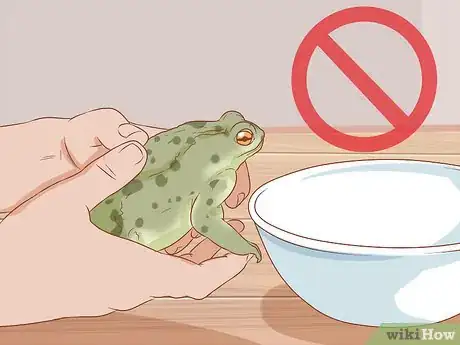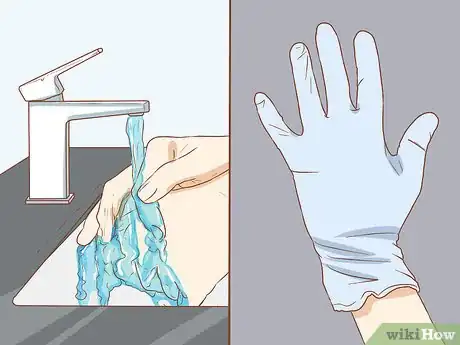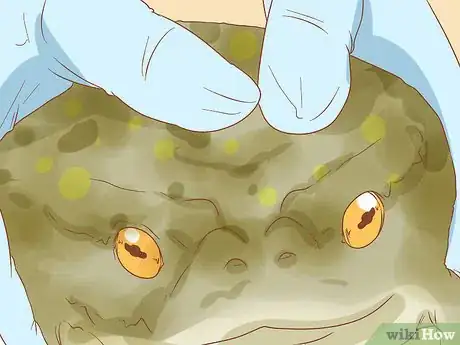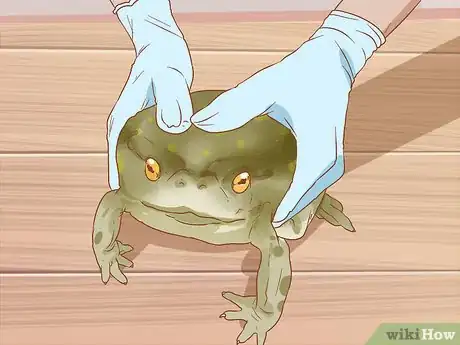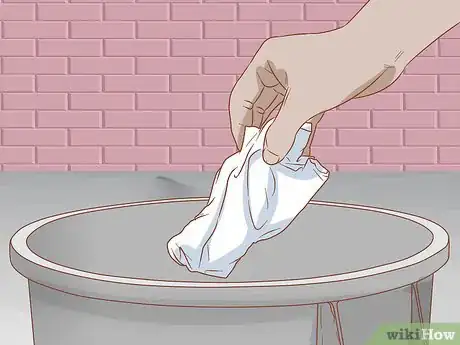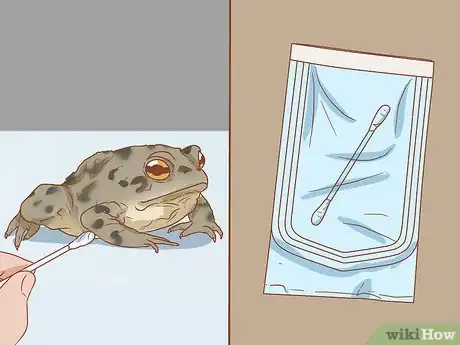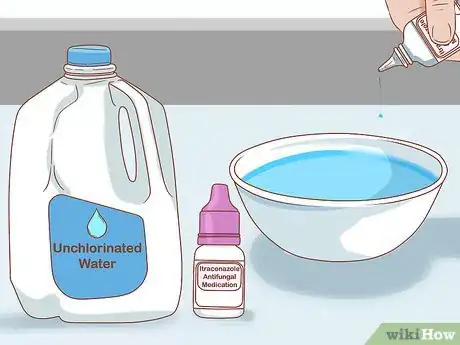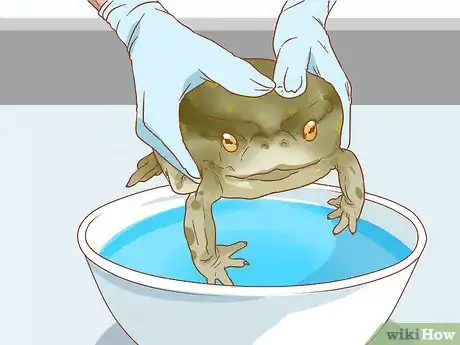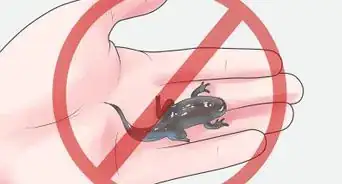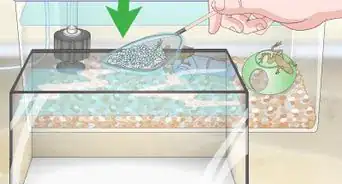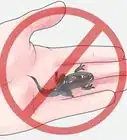This article was co-authored by wikiHow staff writer, Christopher M. Osborne, PhD. Christopher Osborne has been a wikiHow Content Creator since 2015. He is also a historian who holds a PhD from The University of Notre Dame and has taught at universities in and around Pittsburgh, PA. His scholarly publications and presentations focus on his research interests in early American history, but Chris also enjoys the challenges and rewards of writing wikiHow articles on a wide range of subjects.
This article has been viewed 23,504 times.
Learn more...
Under normal circumstances, you should never bathe a pet frog, nor even handle it any more than is necessary. Doing so is a risk to the frog’s health and maybe even your own. Instead, simply provide it with a daily supply of clean, unchlorinated water so it can bathe itself. If you must handle the frog, wash your hands, wear gloves, and be very careful. If—and only if—you are a professional working in a scientific setting, you may need to bathe a frog in an antifungal solution as part of its quarantine procedure.
Steps
Providing Clean Water for Self-Bathing
-
1Choose a bowl that allows your frog to submerge in the water you’ll add. Frogs soak in moisture through their skin instead of drinking water, so choose a bowl or dish that gives them room to soak comfortably. The bowl should permit a water level that’s just barely deep enough for the frog to submerge fully, but shouldn’t be so deep that it’s difficult for the frog to get in and out.[1]
- Stainless steel or ceramic bowls or dishes are good choices. If you use a plastic bowl, make sure it’s non-reactive. Anything that leaches into the water will be absorbed through the frog’s skin.
-
2Add unchlorinated water to the bowl. Don’t use tap water for the frog’s soaking dish, since they are sensitive to chlorine. Home filtering should remove chlorine from your water, but the safer bet is to use jugs of distilled water.[2]
- Fill the bowl with just enough water for the frog to submerge its entire head and body.
Advertisement -
3Empty, clean, and refill the bowl every day. Because frogs like to lounge in their soaking bowls, things like food scraps and feces will build up in the water. Each day, dump out the water and rinse the bowl. Then, wash the bowl with a clean rag and a very mild soap. Rinse away the soap fully under the faucet, then give a final rinse with unchlorinated water.[3]
- After the final rinse, dry the dish with a clean paper towel, refill it with unchlorinated water, and return it to the frog’s enclosure.
-
4Don’t try to give your frog a bath. Frogs are adept at self-cleaning, and should be left alone as much as possible. Handling a frog, as would be necessary to bathe them, causes them a great deal of stress and may expose them to bacteria or chemicals. Just focus on giving your frog clean water every day.[4]
- Even healthy frogs can carry salmonella bacteria, so you should only touch a frog when necessary. Keep frogs away from children under 5 because of their heightened risk of illness from exposure to salmonella.[5]
Handling a Frog Properly
-
1Wash your hands and put on vinyl gloves. Any germs, chemicals, oils, etc. on your hands will be absorbed through the frog’s skin and can damage their health. Wash your hands thoroughly with soap and water, and dry them with a clean towel. After that, put on a pair of sterile, powder-free vinyl gloves.
- Putting on gloves also protects you. Frogs, even healthy ones, very frequently carry salmonella bacteria on their skin.
-
2Place your gloved thumb just below the frog’s head. Work calmly and move slowly so you don’t frighten the frog any more than is necessary. Touch the tip of your thumb against the base of the frog’s neck in preparation for scooping it up.
- This thumb placement should be done in conjunction with the scooping procedure done with your fingers, described below.
-
3Scoop your other fingers underneath the frog’s body. With your thumb in place behind the frog’s head, scoop your other four fingers under its body so that the frog is contained within your hand. Grasp only tightly enough that the frog cannot escape—don’t squeeze!
- If the frog is too big for one hand, mirror the process with your other hand as well—place both thumbs on the back of the neck and scoop around each side with your hands.
-
4Lift, carry, and release the frog carefully. Keep your loose but secure grip on the frog as you transport it calmly but quickly to its destination. When it’s time to release the frog, reverse the pick-up process—lower your holding fingers to the floor, uncurl them from around the frog, and lift your hand away.
- The frog may squirm and try to escape, so make sure you don’t drop it. Even a short fall can be fatal to a frog.
- The frog may urinate or defecate on you out of fear. Ignore this and keep transporting it carefully.
-
5Discard your gloves and wash your hands thoroughly. As soon as you’re done moving the frog, peel off your gloves and throw them away inside-out. Then, wash your hands for at least 20 seconds with clean water and soap. Dry them with a clean towel.
- Children under 5 should not handle frogs, even if the proper precautions are taken. They’re too likely to drop the frog, and they’re more susceptible to salmonella-related illness.[6]
Giving Antifungal Baths During Lab Quarantine
-
1Test a newly-captured wild frog for chytrid immediately. Amphibian chytrid (chytridiomycosis) attacks a frog’s skin cells, spreads rapidly from frog to frog, and is often fatal. All wild frogs should be immediately tested for chytrid by swabbing their sides and belly 5 times each with a sterile testing swab. Seal the swab in a sterile bag for testing in the lab.[7]
- Wild frogs should only be captured for research purposes by trained professionals. Do not try to capture a wild frog to keep it as a pet. It may be illegal, depending on the frog type, and it endangers the health of the frog and possibly you.
-
2Isolate the frog for 30 days as a preventative measure. Every newly-captured wild frog should be kept in isolation from other frogs for 30 days, and started on antifungal treatment even before the chytrid test results come back.[8]
- Any legitimate operation that captures wild frogs for research purposes should have a dedicated isolation area for new frogs.
-
3Mix an antifungal bathing solution containing itraconazole. Combine unchlorinated water (not tap water) and the antifungal medication itraconazole at a dosage of 10 milligrams per milliliter of water.[9] You only need enough of the solution to fill a container to the point that the frog can just barely submerge itself in the liquid.[10]
- Itraconazole is a prescription medication used to treat a range of fungal infections in humans.
-
4Pick the frog up to put it in its antifungal soak. Start by washing your hands and putting on vinyl gloves. Place your thumb just behind the frog’s head, then scoop your other fingers around and underneath the frog. Grasp it just enough to keep it from escaping. Wash your hands thoroughly after handling the frog.
- Pick up a frog only when necessary. It causes them a great deal of stress, and it is easy for you to transfer bacteria and illnesses back and forth.
-
5Let the frog soak in the solution for 10 minutes per day for 10 days. Carefully lower the frog into the container with the antifungal solution, then release your hand from around it. Leave it in the antifungal container for 10 minutes, then carefully return it to its isolation tank. Repeat this process over the following 9 days.[11]
-
6Test the frog again, and keep it in quarantine for 30 days total. After the 10 days of treatment, test the frog for chytrid once again. Keep the frog in isolation for 20 more days, for a total of 30 days. If the second chytrid test comes back clean, the frog can be released from isolation.[12]
- If the second chytrid test comes back positive, start another 10-day regimen of antifungal baths.
Community Q&A
-
QuestionHow do I hold a toad properly?
 Community AnswerYou really just want to hold them under the belly. Belly on your palm and wrap fingers around it. Hold it lightly.
Community AnswerYou really just want to hold them under the belly. Belly on your palm and wrap fingers around it. Hold it lightly. -
QuestionIs dirt from my garden okay to put in my tadpole tank?
 Community AnswerYes, though small stones are much better, as they provide hiding places. You will have to clean out the tadpole's tank more frequently.
Community AnswerYes, though small stones are much better, as they provide hiding places. You will have to clean out the tadpole's tank more frequently. -
QuestionWhat if my frog has a broken leg?
 Community AnswerIf you believe your pet frog has a broken leg, please take it to a veterinarian as soon as possible. If there are nearby vets who specialize in exotic animals, they may be the best choice, as they tend to treat more reptile and amphibians.
Community AnswerIf you believe your pet frog has a broken leg, please take it to a veterinarian as soon as possible. If there are nearby vets who specialize in exotic animals, they may be the best choice, as they tend to treat more reptile and amphibians.
References
- ↑ http://www.frogdaze.com/caring-for-your-frog.html
- ↑ http://www.frogdaze.com/caring-for-your-frog.html
- ↑ http://www.frogdaze.com/caring-for-your-frog.html
- ↑ http://www.frogdaze.com/caring-for-your-frog.html
- ↑ https://www.health.ny.gov/diseases/communicable/zoonoses/salmonella/amphibian_reptilian_questions_and_answers.htm
- ↑ https://www.health.ny.gov/diseases/communicable/zoonoses/salmonella/amphibian_reptilian_questions_and_answers.htm
- ↑ http://amphibianrescue.org/2010/08/18/giving-a-frog-a-bath-and-other-treatments/
- ↑ http://amphibianrescue.org/2010/08/18/giving-a-frog-a-bath-and-other-treatments/
- ↑ https://www.conservationevidence.com/individual-study/4889
About This Article
Before you bathe a frog, keep in mind that you should never bathe a frog unless you're giving it an antifungal bath during a laboratory quarantine since you could expose it to harmful bacteria or chemicals. Instead, provide a bowl filled with dechlorinated water in the frog's habitat so it can bathe itself. Make sure the bowl is deep enough for the frog to submerge itself in but not deep enough that it has trouble getting out. For tips on how to safely handle a frog, scroll down!



